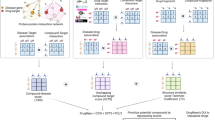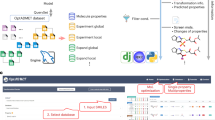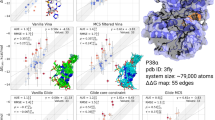Abstract
Drug-likeness is a key consideration when selecting compounds during the early stages of drug discovery. However, evaluation of drug-likeness in absolute terms does not reflect adequately the whole spectrum of compound quality. More worryingly, widely used rules may inadvertently foster undesirable molecular property inflation as they permit the encroachment of rule-compliant compounds towards their boundaries. We propose a measure of drug-likeness based on the concept of desirability called the quantitative estimate of drug-likeness (QED). The empirical rationale of QED reflects the underlying distribution of molecular properties. QED is intuitive, transparent, straightforward to implement in many practical settings and allows compounds to be ranked by their relative merit. We extended the utility of QED by applying it to the problem of molecular target druggability assessment by prioritizing a large set of published bioactive compounds. The measure may also capture the abstract notion of aesthetics in medicinal chemistry.
This is a preview of subscription content, access via your institution
Access options
Subscribe to this journal
Receive 12 print issues and online access
$259.00 per year
only $21.58 per issue
Buy this article
- Purchase on Springer Link
- Instant access to full article PDF
Prices may be subject to local taxes which are calculated during checkout




Similar content being viewed by others
References
Keller, T. H., Pichota, A. & Yin, Z. A practical view of ‘druggability’. Curr. Opin. Chem. Biol. 10, 357–361 (2006).
Ursu, O., Rayan, A., Goldblum, A. & Oprea, T. I. Understanding drug-likeness. Wiley Interdis. Rev.: Comp. Mol. Sci. 1, doi: 10.1002/wcms.1052 (2011).
Oprea, T. I. Property distribution of drug-related chemical databases. J. Comput. Aided Mol. Des. 14, 251–264 (2000).
Leeson, P. D. & Springthorpe, B. The influence of drug-like concepts on decision-making in medicinal chemistry. Nature Rev. Drug Discov. 6, 881–890 (2007).
Lipinski, C. A., Lombardo, F., Dominy, B. W. & Feeney, P. J. Experimental and computational approaches to estimate solubility and permeability in drug discovery and development settings. Adv. Drug Del. Rev. 23, 3–25 (1997).
Lipinski, C. A. Drug-like properties and the causes of poor solubility and poor permeability. J. Pharmacol. Toxicol. Methods 44, 3–25 (2000).
Abad-Zapatero, C. A sorcerer's apprentice and The Rule of Five: from rule-of-thumb to commandment and beyond. Drug Discov. Today 12, 995–997 (2007).
Hann, M. M. Molecular obesity, potency and other addictions in drug discovery. MedChemComm 2, 349–355 (2011).
Hughes, J. D. et al. Physicochemical drug properties associated with in vivo toxicological outcomes. Bioorg. Med. Chem. Lett. 18, 4872–4875 (2008).
Wenlock, M., Austin, R. P., Barton, P., Davis, A. M. & Leeson, P. D. A comparison of physiochemical property profiles of development and marketed oral drugs. J. Med. Chem. 46, 1250–1256 (2003).
Proudfoot, J. R. The evolution of synthetic oral drug properties. Bioorg. Med. Chem. Lett. 15, 1087–1090 (2005).
Xu, J. & Stevenson, J. Drug-like index: a new approach to measure drug-like compounds and their diversity. J. Chem. Inf. Comput. Sci. 40, 1177–1187 (2000).
Rayan, A., Marcus, D. & Goldblum, A. Predicting oral druglikeness by iterative stochastic elimination. J. Chem. Info. Model. 50, 437–445 (2010).
Ohno, K., Nagahara, Y., Tsunoyama, K. & Orita, M. Are there differences between launched drugs, clinical candidates, and commercially available compounds? J. Chem. Inf. Model. 50, 815–821 (2010).
Harrington, E. C. Jr The desirability function. Ind. Qual. Control. 21, 494–498 (1965).
Cruz-Monteagudo, M. et al. Desirability-based methods of multiobjective optimization and ranking for global QSAR studies. Filtering safe and potent drug candidates from combinatorial libraries. J. Comb. Chem. 10, 897–913 (2008).
Le Bailly de Tilleghem, C., Beck, B., Boulanger, B. & Govaerts, B. A fast exchange algorithm for designing focused libraries in lead optimization. J. Chem. Inf. Model. 45, 758–767 (2005).
Mandal, A., Johnson, K., Wu, C. F. J. & Bornemeier, D. Identifying promising compounds in drug discovery: genetic algorithms and some new statistical techniques J. Chem. Inf. Model. 47, 981–988 (2007).
Wager, T. T., Hou, X., Verhoest, P. R. & Villalobos, A. Moving beyond rules: the development of a central nervous system multiparameter optimization (CNS MPO) approach to enable alignment of druglike properties. ACS Chemical Neurosci. 1, 435–449 (2010).
Paolini, G. V., Lyons, R. & Laflin, P. How desirable are your IC50s? A method to enhance screening-based decision making. J. Biomol. Screen. 15, 1183–1193 (2010).
Derringer, G. & Suich, R. Simultaneous optimization of several response variables. J. Qualty Technol. 12, 214–219 (1980).
Ghose, A. K., Viswanadhan, V. N. & Wendoloski, J. J. A knowledge-based approach in designing combinatorial or medicinal chemistry libraries for drug discovery. 1. A qualitative and quantitative characterization of known drug databases. J. Comb. Chem. 1, 55–68 (1999).
Veber, D. F. et al. Molecular properties that influence the oral bioavailability of drug candidates. J. Med. Chem. 45, 2615–2623 (2002).
Ghose, A. K. & Crippen, G. M. J. Atomic physicochemical parameters for three-dimensional structure-directed quantitative structure–activity relationships I. partition coefficients as a measure of hydrophobicity. J. Comput. Chem. 7, 565–577 (1986).
Lovering, F., Bikker, J. & Humblet, C. Escape from flatland: increasing saturation as an approach to improving clinical success. J. Med. Chem. 52, 6752–6756 (2009).
Ritchie, T. J. & Macdonald, S. J. The impact of aromatic ring count on compound developability – are too many aromatic rings a liability in drug design? Drug Discov. Today 14, 1011–1120 (2009).
Brenk, R. et al. Lessons learnt from assembling screening libraries for drug discovery for neglected diseases. ChemMedChem 3, 435–444 (2008).
Shannon, C. E. A mathematical theory of communication. Bell System Technical J. 27, 379–423, 623–656 (1948).
Hosseinzadeh Lotfi, F. & Fallahnejad, R. Imprecise Shannon's entropy and multi attribute decision making. Entropy 12, 53–62 (2010).
Wager, T. T. et al. Defining desirable central nervous system drug space through the alignment of molecular properties, in vitro ADME, and safety attributes. ACS Chemical Neurosci. 1, 420–434 (2010).
Gleeson, M. P., Hersey, A., Montanari, D. & Overington, J. Probing the links between in vitro potency, ADMET and physicochemical parameters. Nature Rev. Drug Discov. 10, 197–208 (2011).
Knox, C. et al. DrugBank 3.0: a comprehensive resource for ‘omics’ research on drugs. Nucleic Acids Res. 39, D1035–D1041 (2011).
Takaoka, Y. et al. Development of a method for evaluating drug-likeness and ease of synthesis using a data set in which compounds are assigned scores based on chemists' intuition. J. Chem. Inf. Comput. Sci. 43, 1269–1275 (2003).
Lajiness, M. S., Maggiora, G. M. & Shanmugasundaram, V. Assessment of the consistency of medicinal chemists in reviewing sets of compounds. J. Med. Chem. 47, 4891–4896 (2004).
Muresan, S. & Sadowski, J. in Molecular Drug Properties – Measurement and Prediction (ed. Mannhold, R.) 441–457 (Wiley-VCH, 2008).
Lipinski, C. A. in Molecular Informatics: Confronting Complexity (eds Hicks, M. G. & Kettner, C.) (Beilstein-Institut, 2002).
Lipinski, C. A. Overview of hit to lead: the medicinal chemist's role from HTS retest to lead optimisation hand off. Top. Med. Chem. 5, 1–24 (2009).
Wipke, W. T. & Rogers, D. Artificial intelligence in organic synthesis. SST: starting material selection strategies. An application of superstructure search. J. Chem. Inf. Comput. Sci. 24, 71–81 (1984).
Hopkins, A. L. & Groom, C. R. The druggable genome. Nature Rev. Drug Discov. 1, 727–730 (2002).
An, J., Totrov, M. & Abagyan, R. Comprehensive identification of ‘druggable’ protein ligand binding sites. Genome Inform. 15, 31–41 (2004).
Cheng, A. C. et al. Structure-based maximal affinity model predicts small-molecule druggability. Nature Biotechnol. 25, 71–75 (2007).
Halgren, T. A. Identifying and characterizing binding sites and assessing druggability. J. Chem. Inf. Model. 49, 377–389 (2009).
Schmidtke, P. & Barril, X. Understanding and predicting druggability. A high-throughput method for detection of drug binding sites. J. Med. Chem. 53, 5858–5867 (2010).
Southan, C., Boppana, K., Jagarlapudi, S. A. & Muresan, S. Analysis of in vitro bioactivity data extracted from drug discovery literature and patents: ranking 1,654 human protein targets by assayed compounds and molecular scaffolds. J. Cheminform. 3, 14 (2011).
Overington, J. P., Al-Lazikani, B. & Hopkins, A. L. How many drug targets are there? Nature Rev. Drug Discov. 5, 993–996 (2006).
Manchester, J., Walkup, G., Rivin, O. & You, Z. Evaluation of pKa estimation methods on 211 druglike compounds. J. Chem. Inf. Model. 50, 565–571 (2010).
Shimazaki, H. & Shinomoto, S. in Advances in Neural Information Processing Systems Vol. 19 (eds Schölkopf, B., Platt, J. & Hoffman, T.) 1289–1296 (MIT Press, 2007).
Dimitropoulos, D., Ionides, J. and Henrick, K. in Current Protocols in Bioinformatics (eds Baxevanis, A. D., Page, R. D. M., Petsko, G. A., Stein, L. D. & Stormo, G. D.) 14.13.11–14.13.13 (Wiley, 2006).
Gleeson, M. P. Generation of a set of simple, interpretable ADMET rules of thumb. J. Med. Chem. 51, 817–834 (2008).
Congreve, M., Carr, R., Murray, C. & Jhoti, H. A ‘rule of three’ for fragment-based lead discovery? Drug Discov. Today 8, 876–877 (2003).
Luker, T. et al. Strategies to improve in vivo toxicology outcomes for basic candidate drug molecules. Bioorg. Med. Chem. Lett. 21, 5673–5679 (2011).
Acknowledgements
This research received funding from the European Community's Seventh Framework Programme (FP7/2007-2013) under grant agreement N° 223461 and the Scottish Universities Life Sciences Alliance. We thank J. Overington for providing the DrugStore data, R. Brenk for the provision of SMARTS for structural alerts and I. Carruthers for assistance with DrugStore database queries. We also thank the chemistry community of AstraZeneca for participating in the chemistry survey.
Author information
Authors and Affiliations
Contributions
A.L.H. conceived the approach and designed the algorithm. G.R.B. implemented the algorithm, performed the calculations, identified the functions and performed the analysis. G.V.P. developed the use of Shannon entropy as the weighting scheme, J.B. wrote the Pipeline Pilot implementation, S.M. coordinated the survey of AstraZeneca chemists, A.L.H and G.R.B. co-wrote the manuscript and G.R.B. produced the figures. All authors commented on the manuscript.
Corresponding author
Ethics declarations
Competing interests
The authors declare no competing financial interests.
Supplementary information
Supplementary information
Supplementary information (PDF 4086 kb)
Supplementary information
Supplementary information (ZIP 17787 kb)
Rights and permissions
About this article
Cite this article
Bickerton, G., Paolini, G., Besnard, J. et al. Quantifying the chemical beauty of drugs. Nature Chem 4, 90–98 (2012). https://doi.org/10.1038/nchem.1243
Received:
Accepted:
Published:
Issue Date:
DOI: https://doi.org/10.1038/nchem.1243
This article is cited by
-
TM-MC 2.0: an enhanced chemical database of medicinal materials in Northeast Asian traditional medicine
BMC Complementary Medicine and Therapies (2024)
-
DBPP-Predictor: a novel strategy for prediction of chemical drug-likeness based on property profiles
Journal of Cheminformatics (2024)
-
IDSL_MINT: a deep learning framework to predict molecular fingerprints from mass spectra
Journal of Cheminformatics (2024)
-
Generation of 3D molecules in pockets via a language model
Nature Machine Intelligence (2024)
-
Discovery of novel Akt1 inhibitors by an ensemble-based virtual screening method, molecular dynamics simulation, and in vitro biological activity testing
Molecular Diversity (2024)



